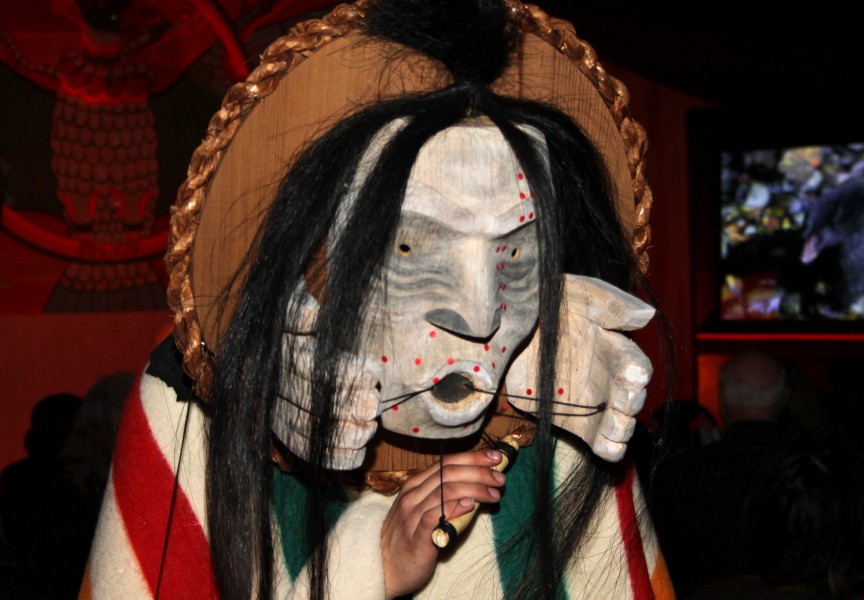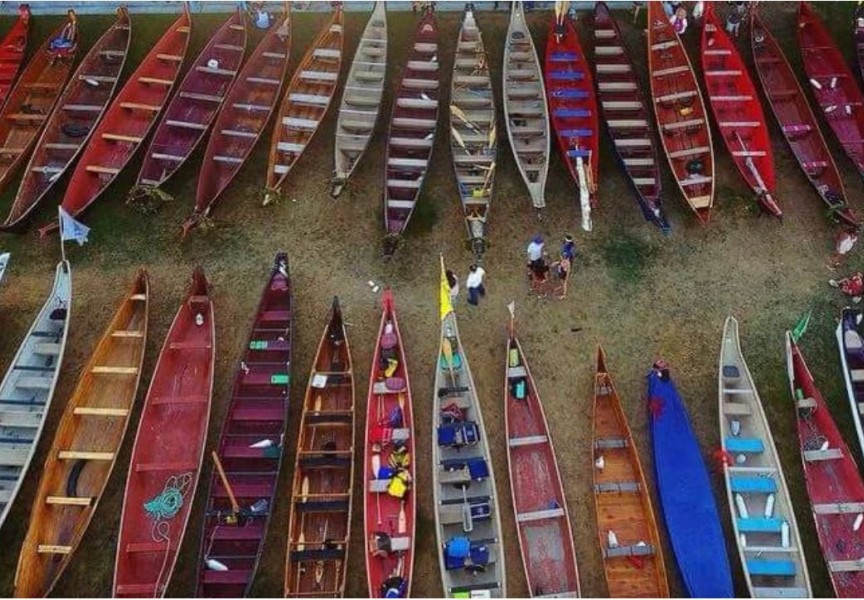K’omoks First Nation welcomed the travelling memorial to Canada’s missing and murdered indigenous women in a special ceremony on July 27. The Walking With Our Sisters exhibit opened July 31 at the K’omoks Band Hall. It is the first (and possibly the only) B.C. stop on the multi-year Walking With Our Sisters tour.
Elder Mary Everson, whose son Rob is the K’omoks elected chief councillor, said her Nation has accepted a great responsibility by hosting Walking With Our Sisters.
“It is very important because we are representing so many different Nations in B.C. and across Canada,” she explained. “We are bringing in the memories of these women in order to draw attention to them, and to find out what happened to them, and to bring closure to their families.”
Everson also helped convince Walking With Our Sisters K’omoks organizers of the need to provide support for grieving family members who attend the exhibit, which runs through Aug. 15.
“There’s going to be many support people here for those who may become overwhelmed, because it’s going to be pretty overwhelming when you think of 1,800 vamps that represent only 1,800 of the thousands that have been missing or have been murdered.” Vamps are beaded moccasin tops.
Courtenay RCMP closed Comox Road July 27 to all vehicle traffic. Just down the road at the Gas N’Go, a single U-Haul truck waited, loaded with the Walking With Our Sisters exhibit and all the support materials. A crew of 16 K’omoks paddlers “propelled” the vehicle towards the K’omoks Big House for the Welcome Ceremony, accompanied by singers and drummers.
As the event proceeded, K’omoks cultural advisors Andy Everson (Rob’s brother) and Wedlidi Speck provided Ha-Shilth-Sa with an explanation of the protocols followed in bringing such a culturally significant collection of material into the community.
When the procession drew close to the Big House, K’omoks Chief Councillor Rob Everson formally asked the purpose of the visit.
Andy Everson, acting as intermediary for the visiting delegation, replied: “They come, bearing medicine for our people, and all aboriginal people across the land. They come on behalf of WWOS as part of a memorial for our murdered and missing indigenous women across this great land; they ask to use our territory to do this great work. They ask our permission to do this.”
After receiving the chief’s invitation, the delegation then proceeded to the Big House. Andy said the arrival protocol he and Rob followed would be familiar to Nuu-chah-nulth-aht.
“Traditionally, our people would go out in our canoes and greet the canoes that were arriving, and escort them to shore. Sometimes, they didn’t speak our language, so we would speak on their behalf. So symbolically, that is what I was doing here.”
Andy also explained that as Walking With Our Sisters has travelled across Canada, each Nation that has hosted the memorial has added to the growing legacy.
“There is a sacred bundle that goes along with WWOS and [K’omoks] will be contributing to that bundle,” he said. “Every time there is a stop, something is added, so it is really a unifying process.”
After welcoming the delegation, organizers and volunteers to K’omoks traditional territory, Rob Everson explained the significance of the Big House, which was built in the late 1950s by his late grandfather, Chief Andy Frank.
“As most of you know, there was a potlatch ban that prohibited our people from celebrating their culture and singing their songs and dancing, which is what we are required to do as a people. In 1951 that ban was lifted. My grandparents had potlatched in secret and they feasted in secret like many of our people did – like many of your people did. They did that to preserve our culture, so that our songs and our dances would be here for generations to come.”
Rob said when he considered what to emphasize in his welcome, it came down to two words: ignorance and awareness.
“The ignorance of Canadians, and of people out there, to the plight of First Nations people, of which murdered and missing women is just one of them. Our mothers, our aunties, our daughters, our sisters… those ones that have gone before us. And the ignorance needs to stop.
“The other word is ‘awareness.’ And it is up to you people in this [Big House] to spread the word. It is up to us to enlighten our fellow Canadians. It is up to us to tell our neighbours, to tell the people we work with – about murdered and missing women.”
Rob predicted the two-week exhibit would bring great emotion and great enlightenment and thanked the many volunteers (over 300) and committee members (more than 50) who made Walking With Our Sisters K’omoks happen.
“We come together to hold each other tight, because that is what we have to do.”
Cultural advisor Wedlidi Speck introduced a number of important community members, including Hereditary Chief Allan Mitchell.
“In our tradition, you are sitting among our nobility – our elders and our grandmothers,” he noted.
Prior to the singing of the Welcome Song and Dance, Andy told guests that the song was composed in Chinook, the working language of B.C. Coastal First Nations. Again, this was a matter of protocol in welcoming outside Nations, he explained.
“When we welcome you here in the Chinook jargon, we say that we are happy you are here, and in the song we say that we are so happy that you are here, we want you to stay. We want you to feel that sense of welcome, your time here, in our territory, your time here, in this [Big House].”
Following the ceremony, Wedlidi singled out Walking With Our Sisters K’omoks coordinator Ramona Johnson for bringing the exhibit to K’omoks traditional territory.
“A long time ago, Ramona heard the call. She had in her heart the goal to bring to light the story of women who are no longer with us.”
Wedlidi said Johnson gradually brought together the core of (mainly) women who made Walking With Our Sisters K’omoks a reality and who would shepherd the exhibit over the two week of the showing. And that is consistent with K’omoks culture, he added.
“In our community, women have always held a strong place. Ours has never been a culture in which men dominated.”
Walking With Our Sisters challenges people to re-examine their beliefs about women and about the importance of family and culture.
“I think about this. I think about when the chief led the way [into the Big House] today, that we came in through the mouths of our elders.”
Those elders, and their elders, suffered from the systematic abuse of their culture, their history and their family structure. K’omoks, like other First Nations, are now reviving and recreating their culture and history, sometimes one child, one song and one dance at a time. And Walking With Our Sisters fits right into that picture, Wedlidi explained.
“It is through all these things that we will grow great strength in all our families. More than any time in the world right now, we have to step up and make sure that our women never lose their voices.”
Tracy Bear, a member of the Montreal Lake Cree Nation, has been with Walking With Our Sisters since its inception. The first exhibit was in Edmonton, near her home territory, and the whole Walking With Our Sisters process has proved to be a unifying force, she said.
“What is so beautiful about it is, as communities hold the community conversations a year before it arrives. Oftentimes, that brings together a community.
“The communities start to grow and they start to build these strong relationships. They build and, long after we’ve left, they still have them.”
Walking With Our Sisters frequently receives emails and letters from former host communities advising that they continue to organize and develop activities flowing from the exhibit, Bear said.
As part of the now fully developed Walking With Our Sisters protocol, the U-Haul truck was backed up to the entrance of the K’omoks Band Hall, where the display was set up. All of the various support materials, carpets, display stands, etc., were unloaded and stacked to the side of the truck.
Only then were the boxes containing the 1,810 vamps unloaded, one at a time, into the hands of waiting volunteers. At the entrance to the hall, two elders from the former host delegation smudged each carrier using their traditional smudge grass, in this case, sage.
K’omoks Band Hall is located at 3320 Comox Road in Courtenay. The exhibit is open from 10 a.m. through 4 p.m. on Tuesdays and Thursdays, and 1 p.m. to 8 p.m. on Wednesdays, Fridays, Saturdays and Sundays, through Aug. 14. The closing ceremony runs from 10 a.m. to 1 p.m., Saturday Aug. 15.
For more information contact I-Hos Gallery at 250-339-7702.






